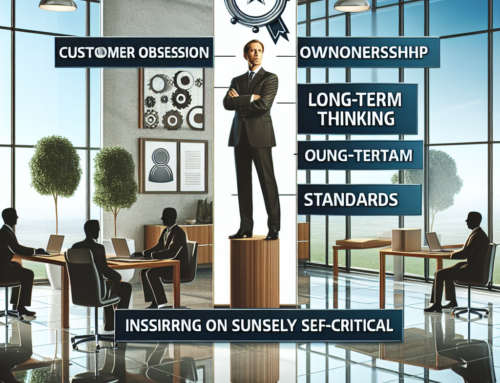
The Early Days: How Jeff Bezos Started Amazon in His Garage
In the early 1990s, Jeff Bezos was a young man with a big dream. He had just graduated from Princeton University and was working on Wall Street when he stumbled upon a statistic that would change his life forever. The internet was growing at an exponential rate, and Bezos saw the potential for online retail. He left his job and moved to Seattle, where he started Amazon in his garage.
At the time, the concept of buying goods online was still relatively new and untested. But Bezos had a vision and a determination to make it work. He started by selling books, as he believed they would be the perfect product to sell online due to their low cost and universal appeal. With a $300,000 investment from his parents, Bezos set up shop in his garage and got to work.
The early days of Amazon were far from glamorous. Bezos and his small team worked long hours, often packing and shipping orders themselves. They had no air conditioning in the garage, so they had to endure the sweltering Seattle summers. But despite the challenges, Bezos was determined to make Amazon a success.
One of the key factors in Amazon’s early success was Bezos’ focus on customer satisfaction. He believed that if he could provide customers with a seamless and convenient shopping experience, they would keep coming back. This led to the development of Amazon’s now-famous one-click ordering system and their efficient shipping and delivery processes.
Bezos also understood the importance of innovation and constantly pushing the boundaries. In 1995, Amazon became one of the first online retailers to offer customer reviews, a feature that is now standard on most e-commerce websites. This not only helped customers make informed purchasing decisions but also created a sense of community around the brand.
As Amazon’s popularity grew, so did its product offerings. Bezos expanded beyond books and started selling a wide range of products, from electronics to clothing to home goods. This diversification helped Amazon become a one-stop-shop for customers, further solidifying its position as a leader in the e-commerce industry.
But with growth came challenges. In the late 1990s, the dot-com bubble burst, and many online retailers went bankrupt. Amazon, however, managed to survive and even thrive during this time. Bezos’ focus on customer satisfaction and innovation helped the company weather the storm and come out stronger on the other side.
In 1997, Amazon went public, and Bezos became a billionaire overnight. But he didn’t let his newfound wealth change his vision for the company. He continued to invest in new technologies and expand Amazon’s reach, including launching Amazon Prime in 2005, which offered customers free two-day shipping and access to streaming services.
Today, Amazon is a household name and one of the largest companies in the world. But it all started in a garage in Seattle, with a young man who had a dream and the determination to make it a reality. Jeff Bezos’ story is a testament to the power of hard work, innovation, and customer focus.
In conclusion, the early days of Amazon were filled with challenges, but Jeff Bezos’ unwavering vision and dedication helped turn it into the e-commerce giant it is today. From humble beginnings in his garage to a global empire, Bezos’ journey is an inspiration to entrepreneurs and dreamers everywhere. And as Amazon continues to evolve and innovate, it’s clear that the company’s early days have laid a strong foundation for its ongoing success.
Innovative Strategies: How Bezos Revolutionized Online Shopping
When we think of online shopping, the first name that comes to mind is Amazon. It’s hard to imagine a world without this e-commerce giant, but it wasn’t always the case. Amazon was once just a small online bookstore, founded by Jeff Bezos in 1994. Today, it is one of the most valuable companies in the world, with a market value of over $1 trillion. So, how did Bezos build Amazon from scratch and revolutionize the way we shop online? Let’s take a closer look at some of his innovative strategies.
One of the key factors that contributed to Amazon’s success was Bezos’ relentless focus on customer satisfaction. He believed that if he could make customers happy, they would keep coming back and bring in more business through word-of-mouth. This customer-centric approach was evident in every aspect of Amazon’s operations, from its user-friendly website to its efficient delivery system.
Bezos also understood the importance of constantly evolving and adapting to the changing market. In the early days of Amazon, the company only sold books. But Bezos had a bigger vision. He wanted Amazon to be the ”everything store,” where customers could find anything they needed. This led to the expansion of Amazon’s product offerings, from electronics to clothing to groceries. Today, you can find almost anything on Amazon, and this has been a major factor in its success.
Another innovative strategy that Bezos implemented was the use of data and analytics. Amazon was one of the first companies to use data to understand customer behavior and preferences. This allowed them to personalize the shopping experience for each customer, making it more convenient and efficient. For example, Amazon’s recommendation engine uses data to suggest products that a customer is likely to be interested in, based on their browsing and purchase history. This not only makes the shopping experience more enjoyable for the customer but also increases the chances of a sale for Amazon.
Bezos also took a bold step by introducing Amazon Prime, a subscription-based service that offers free two-day shipping on eligible items, along with other benefits such as access to streaming services and exclusive deals. This was a game-changer for Amazon, as it not only increased customer loyalty but also encouraged customers to shop more frequently. Today, Amazon Prime has over 150 million subscribers worldwide, and it continues to be a major source of revenue for the company.
In addition to these strategies, Bezos also focused on building a strong and efficient supply chain. He understood that in order to offer fast and reliable delivery, Amazon needed to have control over its supply chain. This led to the development of Amazon’s own logistics network, including warehouses, fulfillment centers, and delivery trucks. This not only reduced Amazon’s reliance on third-party logistics providers but also allowed them to offer faster and more cost-effective delivery options to customers.
Bezos also had a long-term vision for Amazon, and he was not afraid to take risks to achieve it. One such risk was the launch of Amazon Web Services (AWS) in 2006. AWS is a cloud computing platform that offers a range of services to businesses, including storage, computing power, and analytics. This move was initially met with skepticism, but today, AWS is the market leader in cloud computing, generating billions of dollars in revenue for Amazon.
In conclusion, Jeff Bezos’ innovative strategies have played a crucial role in Amazon’s success and its dominance in the e-commerce industry. His relentless focus on customer satisfaction, use of data and analytics, introduction of Amazon Prime, and investment in building a strong supply chain have all contributed to Amazon’s growth and expansion. Bezos’ vision and willingness to take risks have truly revolutionized the way we shop online, and Amazon’s success is a testament to his innovative strategies.
From Books to Everything: The Expansion of Amazon’s Product Range
When Amazon first launched in 1995, it was simply an online bookstore. Founder Jeff Bezos had a vision to create a virtual store where customers could easily purchase books without ever leaving their homes. However, as the company grew and evolved, so did its product range. Today, Amazon offers everything from groceries to electronics, making it one of the largest and most successful e-commerce companies in the world. In this article, we will explore how Jeff Bezos built Amazon from scratch and expanded its product range to include almost everything imaginable.
As Amazon gained popularity as an online bookstore, Bezos saw an opportunity to expand the company’s offerings. In 1998, Amazon began selling music and videos, followed by toys and electronics in 1999. This move was a strategic one, as it allowed Amazon to tap into a wider customer base and increase its revenue. By offering a diverse range of products, Amazon was able to attract more customers and keep them coming back for all their shopping needs.
In 2002, Amazon made its biggest expansion yet by introducing the Amazon Marketplace. This platform allowed third-party sellers to sell their products on Amazon’s website, greatly increasing the company’s product range. This move not only benefited Amazon by bringing in more revenue, but it also provided customers with a wider selection of products to choose from. Today, the Amazon Marketplace is a crucial part of the company’s success, with millions of sellers offering everything from handmade crafts to brand-name products.
In 2005, Amazon launched Amazon Prime, a subscription service that offered free two-day shipping on eligible items. This was a game-changer for the company, as it not only increased customer loyalty but also encouraged them to purchase more products. With the success of Amazon Prime, Bezos saw an opportunity to expand the company’s product range even further. In 2007, Amazon introduced the Kindle e-reader, which revolutionized the way people read books. This move not only expanded Amazon’s product range but also solidified its position as a leader in the e-commerce industry.
In the following years, Amazon continued to expand its product range by introducing new services such as Amazon Fresh for grocery delivery, Amazon Web Services for cloud computing, and Amazon Studios for original content. These expansions not only brought in more revenue for the company but also allowed Amazon to enter new markets and compete with other industry giants.
In recent years, Amazon has made even more ambitious moves to expand its product range. In 2017, the company acquired Whole Foods Market, a high-end grocery chain, for $13.7 billion. This acquisition not only gave Amazon a foothold in the grocery industry but also allowed it to offer a wider range of products to its customers. In 2019, Amazon launched its own line of skincare and beauty products, further diversifying its product range.
Today, Amazon’s product range is almost limitless. From books and electronics to groceries and beauty products, the company truly offers everything under the sun. This expansion has not only made Amazon a household name but also solidified its position as a leader in the e-commerce industry. Jeff Bezos’ vision and determination to constantly innovate and expand have been crucial to Amazon’s success.
In conclusion, Jeff Bezos’ journey to building Amazon from a simple online bookstore to a global e-commerce giant with a diverse product range has been nothing short of remarkable. Through strategic expansions and innovations, Bezos has transformed Amazon into a one-stop-shop for all our shopping needs. As the company continues to grow and evolve, it will be exciting to see what new products and services Amazon will offer in the future.
The Power of Data: How Bezos Used Analytics to Drive Amazon’s Success
When we think of successful entrepreneurs, names like Steve Jobs, Bill Gates, and Mark Zuckerberg often come to mind. However, one name that cannot be overlooked is Jeff Bezos, the founder and CEO of Amazon. Bezos has not only built one of the largest and most successful companies in the world, but he has also revolutionized the way we shop and consume goods. So, what is the secret behind Bezos’ success? Many would argue that it lies in his ability to harness the power of data and use analytics to drive Amazon’s growth.
From the very beginning, Bezos understood the importance of data in making informed business decisions. In fact, he famously stated, ”What we need to do is always lean into the future; when the world changes around you and when it changes against you – what used to be a tailwind is now a headwind – you have to lean into that and figure out what to do because complaining isn’t a strategy.” This mindset has been the driving force behind Amazon’s success, and it all starts with data.
One of the first ways Bezos used data to drive Amazon’s success was through market research. Before launching Amazon, Bezos spent months researching the e-commerce market and identifying potential opportunities. He analyzed data on consumer behavior, market trends, and competitor strategies to determine the best approach for his business. This research allowed him to identify a gap in the market for an online bookstore, which ultimately led to the birth of Amazon.
But Bezos didn’t stop there. He continued to use data to guide Amazon’s growth and expansion. As the company grew, Bezos implemented a data-driven culture, where every decision was backed by data and analytics. This approach allowed Amazon to make strategic decisions that were based on facts rather than assumptions or gut feelings.
One of the most significant ways Bezos used data to drive Amazon’s success was through customer data analysis. Amazon collects vast amounts of data on its customers, including their browsing and purchasing history, search queries, and even their location. This data is then analyzed to gain insights into customer behavior, preferences, and needs. By understanding their customers on a deeper level, Amazon can tailor its products, services, and marketing strategies to meet their needs and provide a personalized shopping experience.
Moreover, Bezos also used data to optimize Amazon’s supply chain and logistics. By analyzing data on inventory levels, shipping times, and customer demand, Amazon can efficiently manage its inventory and ensure that products are delivered to customers in a timely and cost-effective manner. This has allowed Amazon to offer fast and reliable shipping, which has been a significant factor in its success.
Another way Bezos used data to drive Amazon’s success was through the use of algorithms and machine learning. Amazon’s algorithms analyze customer data to make personalized product recommendations, which has been a significant driver of sales. Additionally, machine learning is used to optimize pricing strategies, predict demand, and improve the overall customer experience. This use of data and technology has allowed Amazon to stay ahead of its competitors and continuously improve its services.
In conclusion, Jeff Bezos’ success with Amazon can be attributed to his ability to harness the power of data and use analytics to drive the company’s growth. From market research to customer data analysis and the use of algorithms and machine learning, Bezos has created a data-driven culture at Amazon that has been crucial to its success. As Bezos himself once said, ”In the old world, you devoted 30% of your time to building a great service and 70% of your time to shouting about it. In the new world, that inverts.” And indeed, it is this focus on data and analytics that has allowed Amazon to become the e-commerce giant it is today.
Lessons Learned: Key Takeaways from Jeff Bezos’ Journey with Amazon
Jeff Bezos, the founder and CEO of Amazon, is one of the most successful entrepreneurs of our time. He started Amazon in 1994 as an online bookstore and has since transformed it into a global e-commerce giant, with a market value of over $1 trillion. Bezos’ journey with Amazon has been nothing short of remarkable, and there are many lessons we can learn from his experience.
One of the key takeaways from Bezos’ journey with Amazon is the importance of having a clear vision and being persistent in pursuing it. Bezos had a vision to create an online store that would offer a wide selection of books at affordable prices. He believed that the internet would revolutionize the way people shop, and he was determined to be at the forefront of this change. Despite facing numerous challenges and setbacks, Bezos never wavered from his vision and continued to work tirelessly towards making it a reality.
Another lesson we can learn from Bezos is the value of innovation and taking risks. In the early days of Amazon, Bezos took a risk by expanding the company’s product offerings beyond books. He introduced new categories such as music, electronics, and toys, which were not traditionally sold online. This move paid off, and Amazon’s sales skyrocketed, proving that taking calculated risks can lead to great success.
Bezos also understood the importance of customer satisfaction and the power of word-of-mouth marketing. He made it a priority to provide exceptional customer service and ensure that every customer had a positive experience with Amazon. This led to a loyal customer base and positive reviews, which helped attract more customers through word-of-mouth. Bezos once said, ”If you do build a great experience, customers tell each other about that. Word of mouth is very powerful.”
One of the most significant lessons we can learn from Bezos is the importance of being adaptable and constantly evolving. Amazon started as an online bookstore, but Bezos knew that the company had to evolve to stay relevant and competitive. Over the years, Amazon has expanded its offerings to include services such as Amazon Prime, Amazon Web Services, and Amazon Fresh. Bezos also recognized the potential of e-readers and launched the Kindle, which revolutionized the way people read books. By constantly adapting and evolving, Amazon has been able to stay ahead of its competitors and maintain its position as a leader in the e-commerce industry.
Bezos’ journey with Amazon also teaches us the value of embracing failure and learning from it. Amazon has had its fair share of failures, such as the Fire Phone and the Amazon Auctions platform. However, Bezos never let these failures discourage him. Instead, he used them as learning opportunities and made sure that the company bounced back stronger. Bezos once said, ”I’ve made billions of dollars of failures at Amazon.com. Literally billions of dollars of failures. You might remember Pets.com or Kosmo.com. It was like getting a root canal with no anesthesia. None of those things are fun. But they also don’t matter.”
Lastly, Bezos’ journey with Amazon teaches us the importance of having a long-term perspective and not being afraid to think big. Bezos has always been focused on the long-term success of Amazon, even if it meant sacrificing short-term profits. He has invested heavily in research and development, and his long-term vision has paid off with the success of products like Amazon Prime and Amazon Web Services. Bezos once said, ”We are willing to be misunderstood for long periods of time.”
In conclusion, Jeff Bezos’ journey with Amazon is a testament to the power of having a clear vision, being persistent, taking risks, prioritizing customer satisfaction, being adaptable, embracing failure, and having a long-term perspective. These lessons are not only applicable to entrepreneurship but also to life in general. As Bezos continues to lead Amazon to new heights, we can all learn from his journey and apply these key takeaways to our own endeavors.
We have lots of exciting coming events in Entrepreneurship, Investing and Personal Development. You can find them all here:
www.swedishwealthinstitute.se/events




